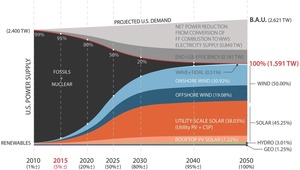Here’s how to convert everything from air conditioners to trucks
 from fossil fuels to 100% renewable sun, wind, and water power by 2050,
generating more jobs than would be lost from dirty energy,
stopping tens of thousands of premature deaths from pollution,
saving about 4% of U.S. GDP, plus saving $3.3 trillion worldwide
climate change costs.
from fossil fuels to 100% renewable sun, wind, and water power by 2050,
generating more jobs than would be lost from dirty energy,
stopping tens of thousands of premature deaths from pollution,
saving about 4% of U.S. GDP, plus saving $3.3 trillion worldwide
climate change costs.
That’s 100% as in no coal, oil, natural gas, nuclear, or biomass, just clean solar, wind, and water power: 90% by 2035, 80% by 2030, and 25% by 2025. No new technology required: just existing solar, wind, and water power production with batteries and hydrogen fuel cells for transportation, plus huge efficiency savings both from using electricity directly and through other well-known techniques.
A cleaner, healthier world is within our reach. And when even the country’s most corrupt legislature can unanimously pass and the Georgia governor who took campaign funds from six pipeline companies can sign a solar financing law, while Georgia has already become the fastest-growing solar market in the country, renewable energy is producing the political will to get this done.
Stanford Report, 8 June 2015, Continue reading

